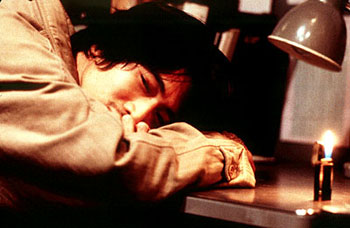![[Metroactive Movies]](/movies/gifs/movies468.gif)
[ Movies Index | Show Times | San Jose | Metroactive Central | Archives ]
Bloody Murder
A baffling series of murders leads to a baffling end
By Richard von Busack
JAPAN HAS BEEN hit by a number of copycat murders, where the victims are found dead with a gory "X" carved into their throats. The details are being kept from the public, so how do these crimes continue? We know: a drifter is approaching previously law-abiding citizens and hypnotizing them into the unthinkable killings. Detective Takabe (Koji Yakusho) is on the case, but he's burdened with a wife, Fumie (Anna Nakagawa), who has lost her mind and frequently wanders into trouble.
Like so many stories of serial killers, Cure appears to be a type of fairy tale. At the opening, the sweet-faced madwoman Fumie is listening to the story of Bluebeard, read to her by a psychiatrist. She responds, "I know how this story ends." But Cure has nothing to do with the story of Duke Bluebeard, save in the sense of Detective Takabe opening his own secret room--his own violent, highly guarded feelings--to the probing questions of the mad killer.
And that killer is kind of an aggravating punk, I thought, who really fancies himself. Maybe the last good murderous hypnotist movie was 1949's Black Magic, starring Orson Welles as the carnival performer Caligostoro. These antique tales can work when you have someone genuinely hypnotic, as Welles was, to enchant the viewer. In the role of the mysterious hypnotist Kunio Mamiya, Masato Hagiwara delivers as serious a case of hair-overacting as early Brad Pitt, peering through the shaggy mane, tossing it back like a coquette. From evidence of the movies, Japan is one place where you can still get a strong reaction by wearing your hair too long,
Mamiya's character uses a kind of aphasic repetition of questions--"Who are you?", "Where is this?"--like a leader at an EST meeting. Remember what detective Philip Marlowe said about Hemingway, that he was a writer who kept repeating things until they sound good? It doesn't sound good here: When the infuriated cops slap Mayima down, I had that reaction I hate so much--hit him again, he's still smirking.
On the whole, Kiyoshi Kurosawa's film can be dismissed as the second failed movie about a mad hypnotist this summer (The Curse of the Jade Scorpion being the first). In the film's final quarter, Cure takes a turn into paranoid mysticism. Despite atmospheric set design--an eerie century-old antique tape recorder delivering a clue, derelict institutional buildings and utility tunnels--the film doesn't point the audience toward a solution. I hoped the riddle would be answered by the madwoman.
Nakagawa's against-the-grain performance as a mad housewife who is as cheery as a Mouseketeer was the most unusual quality of the film. However, Kurosawa drops Nakagawa hard. Cure seems to have been imported, solely for its acts of violence--the only sensation that breaks Cure's hushed, bland surface.
[ San Jose | Metroactive Central | Archives ]
![]()

He's Getting Sleepy, Very Sleepy: Skilled hypnotist Mamiya (Masato Hagiwara) can mesmerize even himself.
Cure (Unrated; 111 min.), directed and written by Kiyoshi Kurosawa and starring Koji Yakusho, Masato Hagiwara and Anna Nakagawa, opens Friday at the Towne Theater in San Jose.
From the September 20-26, 2001 issue of Metro, Silicon Valley's Weekly Newspaper.